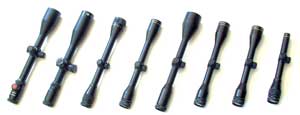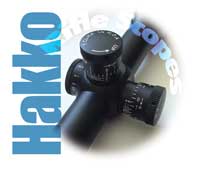Hakko rifle scopes
by Technical Advisor Brendan Atkinson
Australian Shooter April 2002
Late last year, I was told that a new line of scopes would be appearing on gunshop shelves early in 2002. Well, they are here.
 Hakko is a well-known Japanese scope manufacturer and has had 40 years’ experience in this field. Many shooters may be using one of their products without knowing it, as they have produced scopes for other companies for many years.
Hakko is a well-known Japanese scope manufacturer and has had 40 years’ experience in this field. Many shooters may be using one of their products without knowing it, as they have produced scopes for other companies for many years.
Olin Australia (Winchester) will be distributing the new range under the Hakko brand name. It will be emphasised that these scopes are fully manufactured and assembled in Japan and not outsourced to other countries.
Eight riflescopes were supplied for this review. Five were from the ‘Smooth Body’ BH series, which have one-inch aluminium tubes. The other three were from the ‘Superb’ range, which, among other features, have a one-piece aircraft grade aluminium 30mm tube. All have a matte finish and are filled with dry nitrogen.
All Hakko scopes are claimed to be ‘wide angle’ and ‘magnum proof’.
This is a neat little scope that would be absolutely ideal on a rimfire or perhaps a .22 Hornet. For hunting small game on foot out to 150 metres, this is an excellent spread of scope power. It would also be a good choice for spotlighting rabbits, as too much power can be a hindrance at night. The standard duplex-type crosshairs were fine enough in the centre to allow for precise aiming on small targets. The quarter-minute click adjustments were positive and were user-friendly. A raised section of the knob made adjustment possible with thumb and forefinger.
Although these two scopes appear to be similar, the 4x is actually 30cm in length, which is some 3cm shorter than the 6x. The clarity of all of the scopes tested was above average and either of these two scopes would give good service to those who prefer fixed power at the lower magnification. There should be no problem about putting one of these on your favourite centrefire rifle for general use. Both scopes employed the standard duplex reticle, which is arguably the best choice for all round hunting.
This scope is 35.5cm in length and shooters may have to remove the rear sights (if supplied) when fitting to their rifle. Scopes of this power are ideal for longer range sniping at small targets, such as rabbits and crows. The duplex crosshairs are fine enough to allow for precise aiming and a tennis ball at a measured 200 metres could be quartered. The perceived ‘brightness’ of the image in failing light bears testimony to modern lens technology.
The second of the variables tested, the BHZFW 4-12x40 is a longer scope, at 37cm and just less than half a kilo in weight. The most obvious feature is the range focus, also known as ‘parallax adjustment’ or ‘adjustable objective’ by other manufacturers. This allows for precise focussing at high magnifications and is a useful feature. There have been problems with some variables in the past, which would change point of impact when the power was moved from low to high - but not with this scope. The variable power covers a useful range and could be used for various applications with a centrefire rifle.
 At 38cm and 500gm, plus a 56mm objective lens, this is a big scope. It has a one-inch tube, but high mounts will almost certainly be required to clear your barrel. Years ago, when skins were worth something, most professional fox rifles were equipped with 8x56 scopes of some persuasion. The wide field of view, plus the extra light-gathering power, makes this configuration attractive.
At 38cm and 500gm, plus a 56mm objective lens, this is a big scope. It has a one-inch tube, but high mounts will almost certainly be required to clear your barrel. Years ago, when skins were worth something, most professional fox rifles were equipped with 8x56 scopes of some persuasion. The wide field of view, plus the extra light-gathering power, makes this configuration attractive.
The R8 GR reticule is unusual in that it has three thick bars that extend out from the three, six and nine o’clock positions. Along the horizontal crosshair, there are three stadia bars either side of the centre. These are excellent for holding off in crosswinds. The vertical crosshair contains numerous lines for holding over at extreme range, plus a graded series of lines for range estimation. As it is difficult to explain how this works without having the actual scope in front of the reader, I suggest that prospective buyers ask to see one and refer to the comprehensive instructions. An interesting feature is the use of an erector tube coil spring - this is a superior method of ensuring that the point of impact does not change and is often seen on high quality benchrest scopes.
This scope weighs in at more than 600gm, has a 30mm tube and is 40cm in length. Medium to high mounts will be required for most rifles. It has a military-style mil-dot reticule, with four dots extending out from the centre in all four directions. Even those not familiar with this layout will soon appreciate the ease with which targets can be acquired at extreme ranges. Instead of the more common front lens adjustable objective, this scope has a side-mounted arrangement, which is graduated from ten yards out to infinity. The theory behind this, as I understand it, is that a tactical shooter can make adjustments with his left hand, so his right hand is free to control the rifle and trigger while continuing to observe through the scope.
There is a new patented gear zoom system, which utilises a 35-degree cut in the tube. This differs from the usual 270-degree cut required by many scopes. It is claimed that this results in a body strength 34 times stronger than the old method.
The military-style knobs were quite stiff to use and were graduated into quarter-minute clicks. This is a serious scope for serious work and would not look out of place on any quality rifle.
At 42cm in length and 800gm in weight, this is a big scope. The 56mm objective lens dictates that high mounts be used on most rifles. The power range will cover most applications that the average shooter will encounter.
It also features a side mounted range focus, again graduated from ten yards to infinity.
Target type elevation and windage knobs are supplied as standard. It is recommended a rifle be zeroed using this scope and then the owner may set up calibrated rings that are part of the adjusters. Pick a distance, zero the rifle and then set the ring at ‘0’ with the Allen key supplied. Using this set-up, one can always have a reference point to go back to if further adjustments are ever made.
The ‘IL’ in the title refers to this scope having an illuminated dot in the centre of the crosshairs. This works very well in failing light and gives an excellent reference point. However, it is easy to leave the IL power ring in the ‘on’ position and flatten the expensive three-volt battery. One would be well advised to seek out a spare, as these proved hard to find in Adelaide.
All scopes supplied by Olin Australia.
